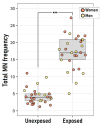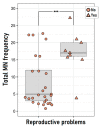Genotoxicity and Reproductive Risk in Workers Exposed to Pesticides in Rural Areas of Curicó, Chile: A Pilot Study
- PMID: 36554491
- PMCID: PMC9779056
- DOI: 10.3390/ijerph192416608
Genotoxicity and Reproductive Risk in Workers Exposed to Pesticides in Rural Areas of Curicó, Chile: A Pilot Study
Abstract
Significant risks to human health have been associated with chronic exposure to low doses of pesticides, a situation which may be frequent among agricultural workers. In this context, and regarding the agricultural-based economy of central Chile, we aimed to explore the genotoxic damage in agricultural workers and reproductive risk among women in rural and urban areas of Curicó, a traditional agricultural district in Chile. Hence, we sampled a group of rural agricultural workers associated with pesticide management (n = 30) and an urban unexposed group (n = 30). Our results showed that the agricultural workers had higher micronuclei frequencies (MN: β = 13.27; 95% CI low = 11.08, CI high = 15.47) and women had a 40-fold higher risk of reproductive problems (OR = 40.32; 95% CI low = 2.60, CI high = 624.31) than the unexposed group. The factor analysis of mixed data (FAMD) showed that neither the sex nor smoking habits appear to define the ordination of the data. Nevertheless, the exposure level did segregate them in the multidimensional space (explained variance: 35.38% dim-1; 18.63% dim-2). This pilot study highlights the higher risks of biological conditions negatively associated with the health of agricultural workers.
Keywords: Chile; agricultural workers; genotoxicity; pesticide exposure; reproductive risk.
Conflict of interest statement
The authors declare no conflict of interest.
Figures




References
-
- Hutter H.P., Poteser M., Lemmerer K., Wallner P., Sanavi S.S., Kundi M., Moshammer H., Weitensfelder L. Indicators of Genotoxicity in Farmers and Laborers of Ecological and Conventional Banana Plantations in Ecuador. Int. J. Environ. Res. Public Health. 2020;17:1435. doi: 10.3390/ijerph17041435. - DOI - PMC - PubMed
MeSH terms
Substances
LinkOut - more resources
Full Text Sources
Medical

